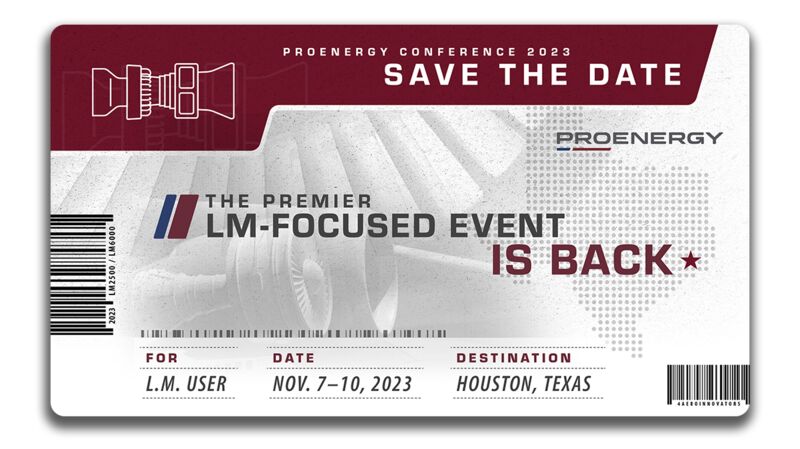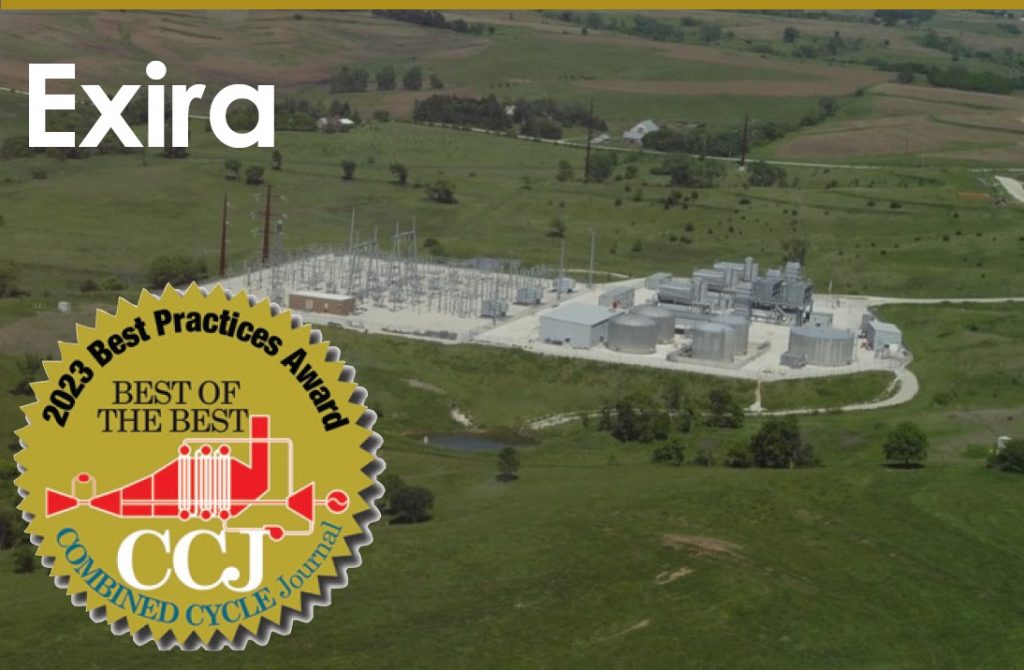
Exira Station
Owned by Western Minnesota Municipal Power Agency
Operated by Missouri River Energy Services
140 MW, 3 × 0 gas-fired peaking facility with diesel-oil backup, located in Brayton, Iowa. The LM6000PC engines are equipped with Sprint
Plant manager: Ed Jackson
Background. Exira Station’s design minimum operating temperature is ‒26F. Plant often is called on to run at sub-zero temperatures and has operated as low as ‒30F.
Operating in extreme cold always is challenging. To ensure the facility is prepared to run in all conditions, plant personnel developed a winterization checklist. The four-page 56-step document lists everything necessary to prepare the plant for wintertime operation. Some steps are quick and simple and only require a couple of minutes or so to complete. Others are more involved and could take up to several days.
While the checklist addresses the more obvious and general things the plant must do to prepare for winter, Exira had several other challenges requiring unique solutions. The list below highlights some of those problems along with their solutions.
Challenge 1. Package heat tracing was unable to keep up with sub-zero temperatures if fans are on. This caused water lines in the package to freeze unless water was flowing in the lines and created a “race” to get water flowing when operating in sub-zero temperatures before lines freeze.
Water injection starts at 5 MW, so the time it takes to push start buttons and fans start, until purge, warm up, and load to 5 MW are complete, is crucial; bad things can happen quickly. If there is a failed start for any reason during this time and another start is needed, there might not be enough heat in the package to prevent a line from freezing before water injection starts.
Solution 1A. Buy more time by operating the supplemental inlet heaters in Fig 1 (which normally don’t start unless the ambient temperature is less than ‒20F) during the start sequence when the ambient drops below zero. This adds a little more heat and helps prevent freeze-up. You can return to auto operation after water-injection flow starts.
Solution 1B. Keep as much heat in the enclosure as possible. MRES and other Midwest operators, have insulated their package bases to do this (Fig 2).
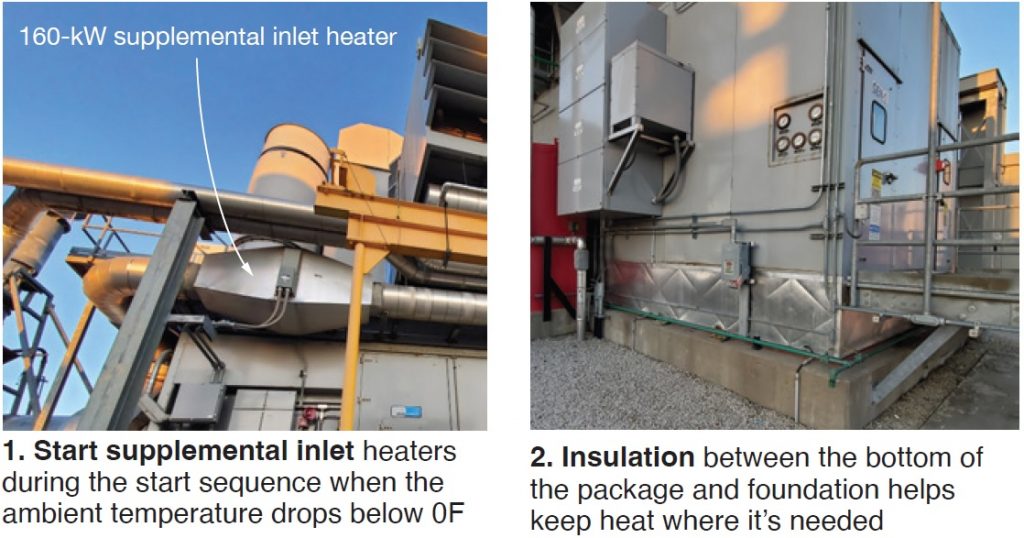
Challenge 2. Failed starts are extremely problematic in cold weather: You may not get another start attempt if the water lines freeze. It’s critical to reduce or eliminate failed starts.
Solution 2A. It’s important to eliminate inconsistent light-offs attributed to low fuel-oil temperatures by setting the fuel-oil-tank immersion heaters to maintain the oil at 60F.
Solution 2B. Starting on fuel oil takes longer to reach the 400F lite-off temperature than starting on gas. To reach 400F faster, within 40 seconds, increase the fuel-oil-valve lite-off percent from 12% to 14%.
Challenge 3. After a stop and subsequent cooldown period with the fans running, the package is cold. A restart would start fans and purge again. Since components already are cold from fans running during the previous cooldown, things could freeze faster than previously. You may not be able to start again because of freeze issues.
Solution 3A. Shared solutions with Solution 1 above.
Solution 3B. Give the package time to warm back up after a start. Exira has adjusted its offer parameters to the RTO to limit restarts in winter to every four hours, giving the packages time to heat back up. If the RTO wants to shut down and restart, and the time between stop and start is minimal, plant has sometimes self-scheduled to “bridge” the runs to prevent restarts as noted above. Bear in mind that starts are fickle in sub-zero temps and a failed start cannot be afforded.
Challenge 4. Cooldown times can be longer than necessary during subzero temps. Fans running longer than necessary can increase the time it takes for the package to warm up, or could freeze pipes.
Solution 4. Exira added logic to stop a cooldown if (1) it has been running for at least 15 minutes, (2) the zero speed detected is true, and (3) the enclosure temperature is less than 32F.
Challenge 5. Fans can run for reasons other than package cooling—gas-sensor drift, for example. If fans start when water is not flowing, the piping and water valves can freeze-up. Consider buying a new valve if you freeze-up the one in service. The bottom line: Prevent fans from running if water is not flowing or going to flow.
Solution 5. Logic was added to stop fans if the unit is not in a sequence (that is start, stop, cooldown, crank, etc) and enclosure temperature is less than 32F. There is still protection against gas leaks, as the gas valve will close if LEL continues to drift up. The operator can still take action to run fans from the DCS if needed to purge.
Challenge 6. Fuel-oil filters can wax-up faster than the operators can change them. Exira’s oil terminals are over 90 minutes away and the fuel must be trucked in. During extreme cold, by the time oil gets to the plant it is less than 20F—possibly as low as 5F.
Oil-tanker capacity is about 7500 gallons, but the plant can burn much more than that hourly. In fact, oil often burned faster than Exira can receive it. Problem is that when filling a tank as you draw from it, the cold oil sinks to the bottom of the tank and is immediately pumped to the operating units. The cold oil waxes up all the filters and creates differential pressures high enough to trip the units if plant personnel don’t respond quickly.
The tankers line up and are offloaded continuously, filling the tanks with cold oil faster than the tank immersion heaters can keep up, and the fuel-oil temperature drops.
Solution 6A. Keep storage tanks at their maximum levels at all times. This way the fuel has enough time in the tank to warm up to 60F and if the plant must operate on oil hopefully there’s sufficient volume to get it through the run.
Solution 6B. Exira installed a bypass to allow fuel oil to flow through a prefilter and back to the tank (Fig 3). This permits the plant to circulate fuel when the unit is shut down—circulating it through the filter and cleaning it continuously, thereby preventing filter plugging when producing power. Operators are busy enough during oil runs and extending the time between filter changes makes a huge difference.
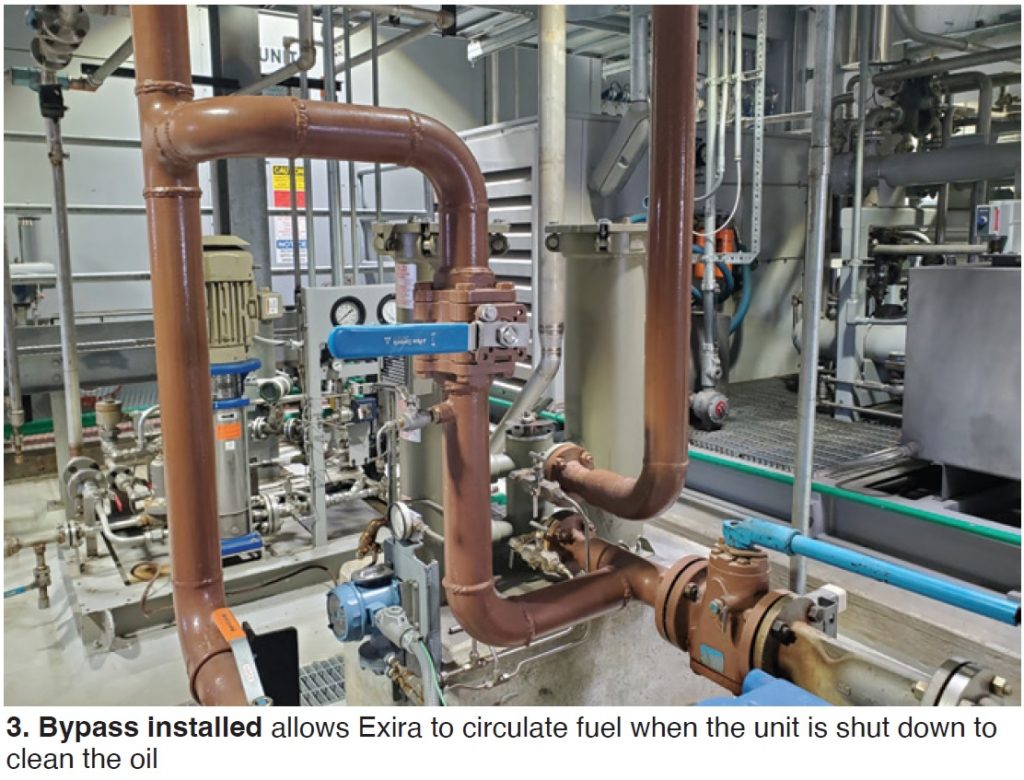
Solution 6C. Exira is installing a fuel receiving and conditioning system, soon to be commercial. It will have two 150-kW inline fuel-oil heaters, and filters, in the line from the tankers to the storage tanks. This will help prevent waxing by heating the fuel before it gets to the tank.
Plus, when fuel is not being received from the tanker, the system can switch to recirculating oil in the storage tank to help the immersion heater get the temperature back to where it needs to be, while filtering the oil at the same time.
It will be possible to recirculate, heat, and filter one of the plant’s two tanks while filling the other. A 4-in. articulating unloading nozzle also is being added, giving Exira the ability to quickly connect to tankers. An Allen Bradley Flex I/O rack will bring the unloading system into the plant control system for better monitoring and control.
Challenge 7. The legacy cement pad used to park trailers was dished for containment, making it dangerous to use when the sloping sides were covered by ice.
Solution 7. The original pad was removed and a new one poured, eliminating the problematic slope. This pad has a redesigned drain for containment to increase safety.
Challenge 8. The demineralized-water trailer sits outside on a cement pad with fire hoses to connect to plant piping that send raw water to the trailer, and demin water from the trailer to the plant. This creates many problems—including freeze-up of access doors preventing operators from gaining access to the trailer, and the need to handle hoses in sub-zero temperatures. Staff cannot leave the hoses outside overnight and when needed in the morning must pull them out, connect them, and get water flowing before it freezes.
When finished making water for the day, staff must shut down the demin system and disconnect the hoses and pull them into a heated building before they freeze-up. If the demin system shuts down automatically because of a system upset, personnel must rush to get hoses pulled inside before the water in them freezes.
It’s almost impossible to handle a frozen 2.5-in.-diam water hose. At times, personnel had to abandon the hoses in place and run new ones to keep water flowing. Also, trailers have been frozen in place with large ice dams preventing staff from replacing the trailers.
Solution 8. Exira is enclosing the demin-trailer pad and making it a heated building (Fig 4). When complete, it will accommodate two trailers side by side. A 26- × 18-ft roll-up door is being installed to close the building. This will greatly increase safety by preventing ice in the demin-trailer area and not having to handle water hoses during extreme cold conditions. Also, it will increase reliability by allowing access to the trailer and hoses at any time.
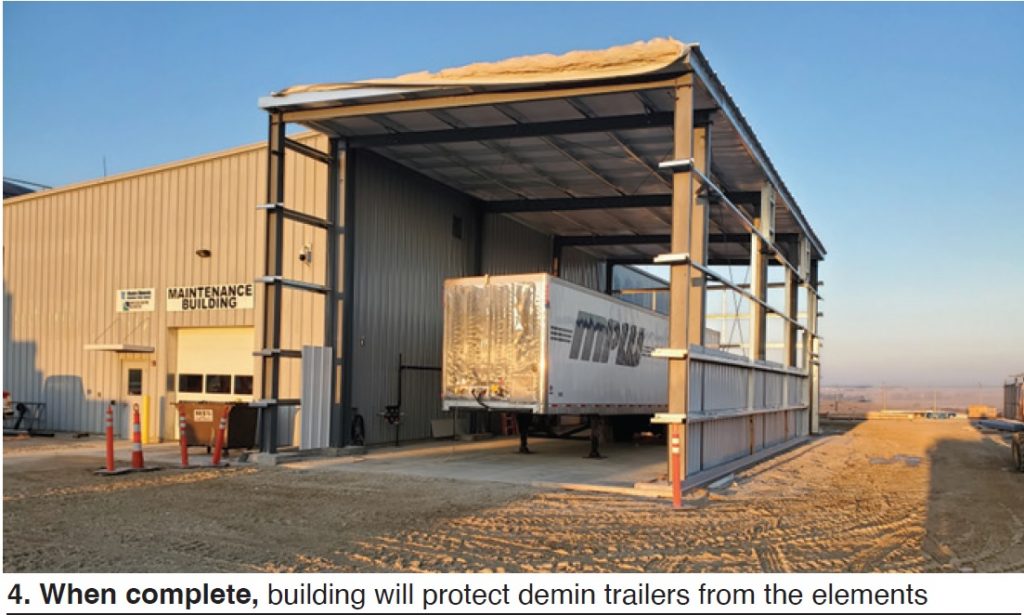
Project participants:
Ed Jackson, plant manager
Tyler Furgeson
Tony Knapp
Devon Meyer
Baker Group (contractor)
2023 Best of the Best from the LM6000 fleet
- WattBridge: Roving work crews effectively support small onsite staffs
- WattBridge: Seasonal shelters protect plant equipment in winter
- WattBridge: Modeling for successful proactive remote monitoring and diagnostics
- Exira: Freeze-protection improvements assure high availability, reliable starts in winter



